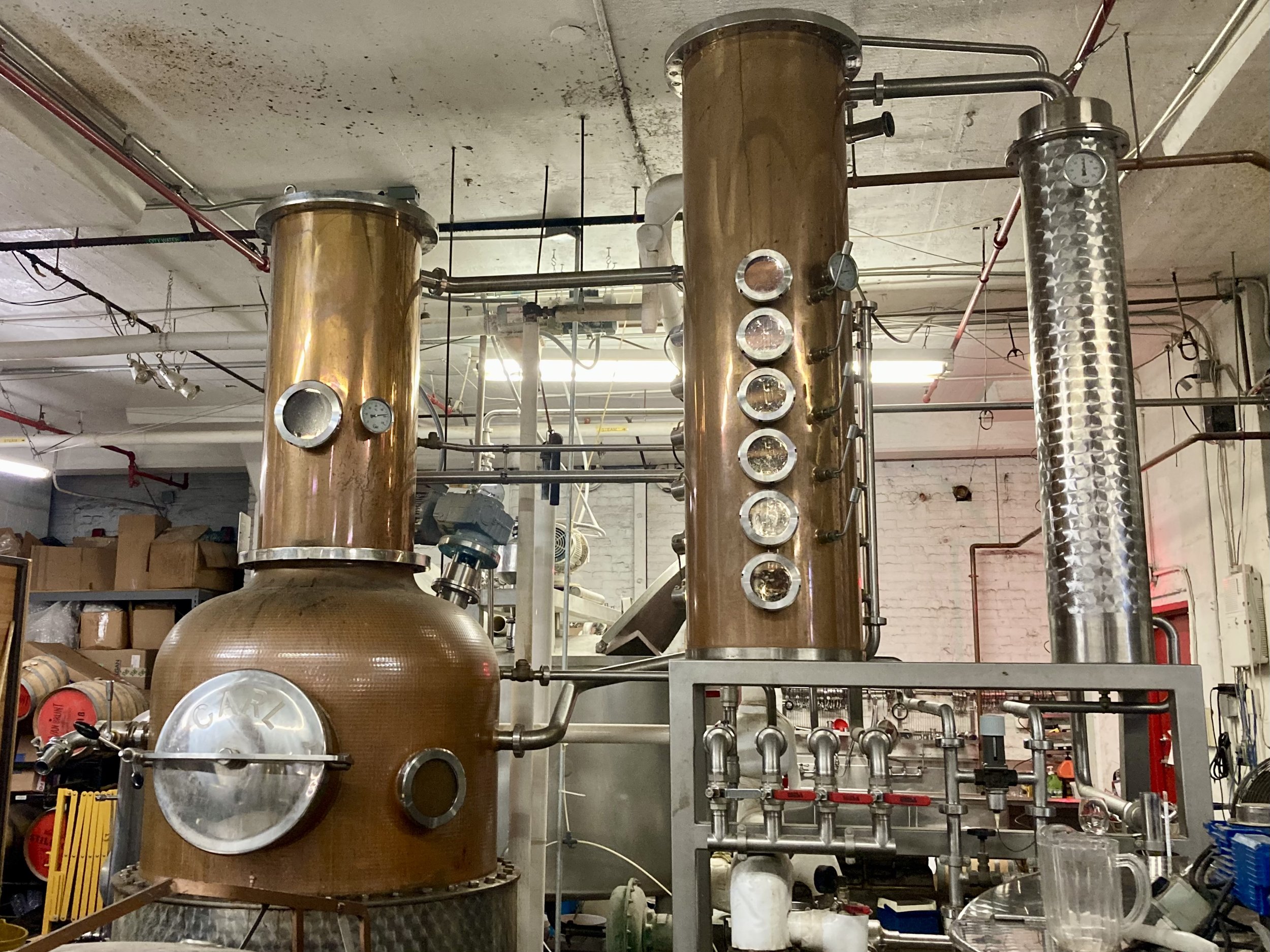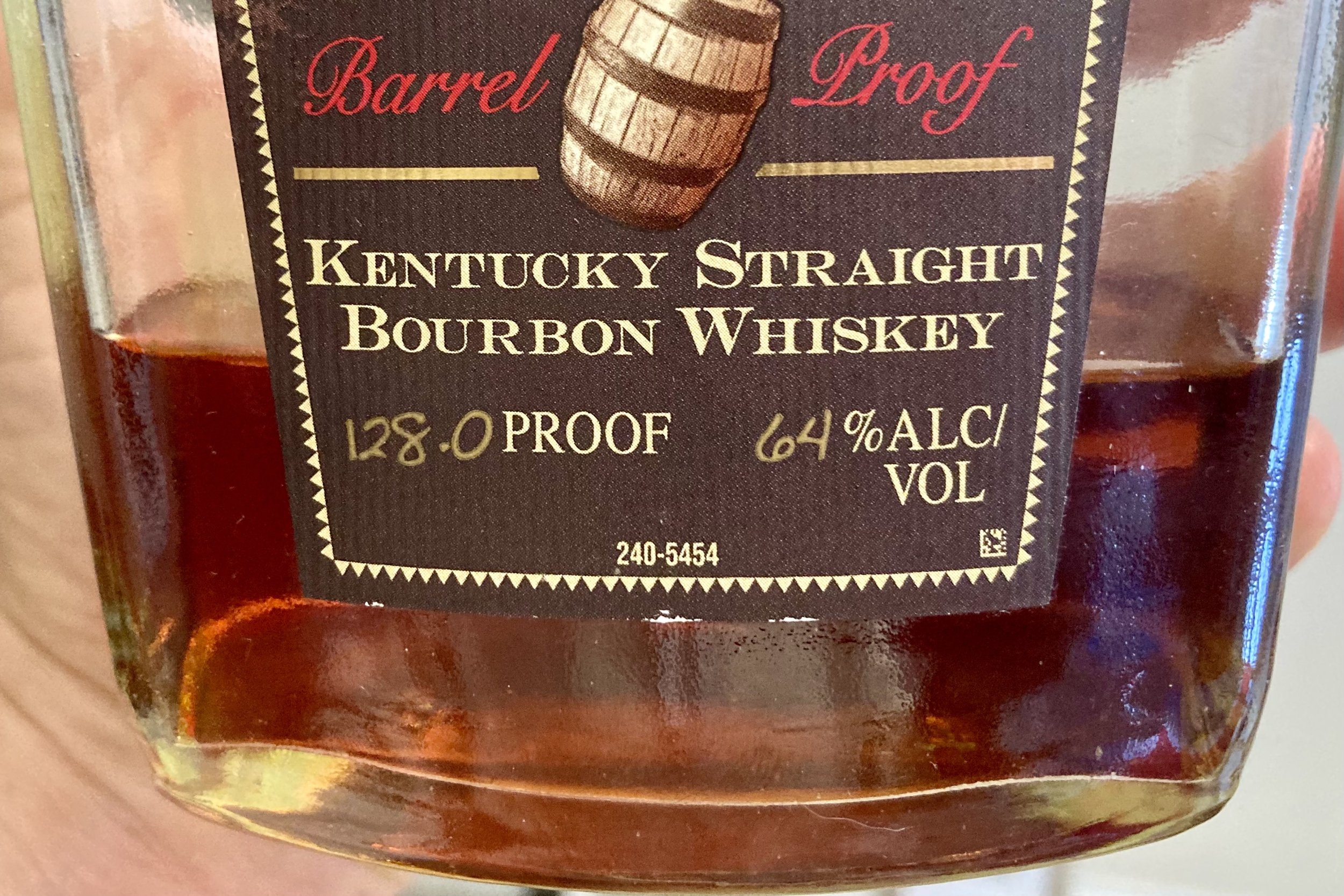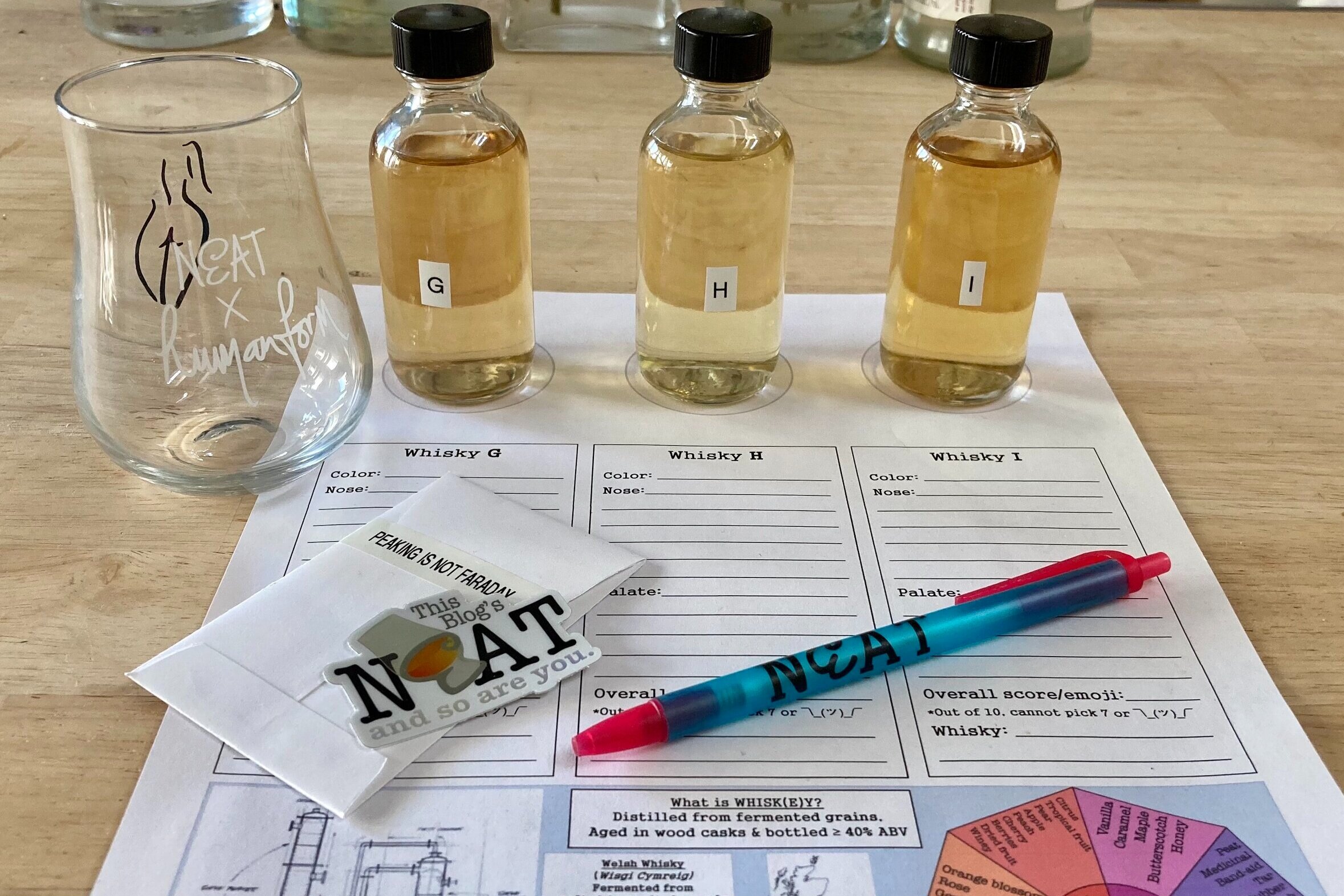
This Blog’s NEAT
Welcome! I’m Robyn and this is my blog! Actually, it’s a little bit more than just a blog. You’ll be able to find posts about all things distilled spirits, join in on our tastings (both virtual & in-person), & book your own private tasting event all right here.
The industry as a whole feels somewhat intimidating and vast! So typically people will get comfortable in one category and not branch out to other categories because they are unknown. I understand this from a personal level and want to help others open their minds to other categories by making it simpler to understand the different types of spirits categories and subcategories without completely dumbing things down. I turned to ChatGPT to see if it could help me and to test it’s distilled spirits knowledge!
I’m currently bundled up on the couch online shopping for Christmas gifts. My default is to give everyone whiskey themed gifts because that’s what I know best. Luckily, most of my friends and family are whiskey drinkers anyways. If you’re looking for gift ideas for the whiskey lover in your life, then here are 5 types of gifts that would be perfect for any whiskey lover… along with many examples!
Jerry and I took an impromptu trip and our first stop was Denver. We only had time to visit one distillery while we were there. I chose a distillery that produces exclusively single malts, sourcing 90% of the barley that they use from local farms and paving the way for the American single malt category. They were founded in 2004 making them the first distillery to open in Colorado after prohibition. You already know who I’m talking about… we visited Stranahan’s Colorado Whiskey!
Want to know how to tell yeast and bacteria apart just by looking at them under the microscope? It’s easy!
Recently I was able to spend some time in NYC and was so excited to pop in to Van Brunt Stillhouse located in Brooklyn. They are a farm distillery embracing the fact that whiskey is an agricultural product and they just celebrated their 10 year anniversary the week before we got there. I would highly recommend checking out Van Brunt Stillhouse! You can really taste that each whiskey was artisanally handcrafted.
Proof is simply just twice the percent alcohol by volume (ABV). But it seems silly to have both ABV and proof listed on a bottle of distilled spirits. So how did proof come to be? The development of the term “proof” in reference to alcohol concentration has many stories. Not all of them are historically accurate and I’ve definitely told the more fun ones that may or may not just be myths. Ultimately what it comes down to is taxes. Talking taxes is no fun, so allow me to start with the fun stories!
There are so many meaningless words on whiskey labels that just add more confusion to which bottle you should buy. These frivolous words don’t give any indication to what the whiskey will actually taste like and as consumers, what we really care about is whether or not we’re going to enjoy the whiskey. So let’s go over them!
Last weekend I ventured 1 hour & 45 minutes up the coast to Ventura Spirits, located in Ventura, CA. And it is such a cool, down-to-earth distillery producing craft spirits… I don’t use the word “craft” lightly. All of the ingredients used for their spirits are sourced from local farms around Ventura and they constantly have the goal of reducing waste in mind. If you are ever on the west coast, Ventura Spirits is definitely worth a visit!
This year, I curated four different whiskey advent calendars to choose from. Each one was filled with either 12 or 24 delicious whiskies from all over the world. The advent calendar I chose for my countdown to Christmas was, of course, the 12 Days of Top-Shelf Whisk(e)y. Here are my tasting notes!
Do you ever wonder “how much does that whiskey cost?”
Well, we’ve created a handy dandy list of whiskey MSRPs for your reference.
Would you rather watch videos than read?
Lucky for you, I have a YouTube channel where I document the experiments that I’m working on, taste various spirits, look at neat things under the microscope, and discuss the science of distilled spirits!
Recaps from our Blind Tastings
During the the COVID19 lockdown, I curated and hosted biweekly blind tastings for This Club’s NEAT members. Each tasting had its own theme that allowed the participants to understand how various aspects of the whiskey-making process impact the flavors of whiskeys. I specially selected the whiskeys (or other spirits) so that participants were able to taste these impacts firsthand. The whiskeys were all tasted blind! Meaning the participants had no idea what they were tasting until after they tried each sample. Blind tasting allows you to taste without having any preconceived notions about what you’re trying. I still host blind tastings in person now, but if you’re looking to do one of my tastings at home, I also offer DIY Blind Tasting Kits.
On July 24th we had our first ever rum tasting and it was a blast! Most who joined the tasting were self-proclaimed whiskey drinkers with preconceived notions about rums. One of those assumptions was that rum is always sweet. This is a common misconception, but rum (that hasn’t been sweetened) isn’t any sweeter than whiskey or brandy. And this tasting definitely helped to prove that not all rums are sweet! Read more about rum and what we tasted here!
St Patrick’s Day (also my dad’s birthday) needs to be celebrated with Irish whiskey. So that’s precisely what we did. We tasted three very unique Irish whiskeys rather than the conventional ones that you might pair with your Guinness. Read more about Irish whiskey and what we tasted here!
During this tasting we tried three different barrel finished American whiskeys and boy, were they delicious. Barrel finishing is when matured whiskey is transferred to another cask prior to bottling to add an additional layer of flavor and complexity to the whiskey. It’s a relatively new concept that’s becoming more popular in the American whiskey industry. Read more about finishing whiskey and what we tasted here!
Last weekend we celebrated Galentine’s Day by tasting three different Welsh single malts produced by Penderyn Distillery. Penderyn produces a uniquely light spirit through a single distillation using a Faraday still, which is named after the inventor, Dr. David Faraday (yes, related to the physicist, Michael Faraday). You might be wondering why we chose to celebrate Galentine’s Day by tasting Penderyn single malts. Well, everyone on their distillation team is female! Read more here!
I had such a phenol-menal time this weekend during Blind Tasting No. 12: Sneaky Peat and I have definitely overused that pun. Get it? Because phenols come from peat smoke and give peated whiskies their smoky flavors. Anyways… During the tasting we discussed where peat makes its way into the whiskey making process and how it impacts the flavor profile of whiskies. Typically peated whiskies come from the Islay region of Scotland (ex: Laphroaig, Lagavulin and Ardbeg), but we tasted three peated whiskies from different parts of the world. Sneaky sneaky. Here’s what we tried!
It felt like the holidays just came and went this year, so we kicked off the first blind tasting event of 2021 with whiskeys that taste just like holiday treats! Whether that means Christmas cookies, mincemeat pie, toffee, mulled wine or coquito to you, all of those flavors could be found in these whiskeys (more or less). Check out what we tasted here!
Aging or finishing whisky in sherry butts is common practice in the Scotch industry as it adds a layer of complexity to the final product. The flavors that the whisky picks up will depend on the sherry that was previous in the cask, meaning different sherry butts will have different impacts on the whisky. During Blind Tasting No. 10, we got to experience this first hand with Tomatin’s Cuatro Series. We tasted the same Highland single malt from Tomatin Distillery that was finished in four different first-fill sherry butts: fino, manzanilla, oloroso and pedro ximenez. The impact of the different sherries is very subtle, making this tasting the most challenging to date! Not to mention, there were four whiskies this time. Here’s a little bit about what we tried!
During this tasting we tried three different rye whiskeys that were all different styles. The members didn’t know which whiskeys they were trying, so based entirely on their senses they had to determine which whiskey was 100% rye mash, Monongahela style (no corn in the mash bill) and Kentucky style (51% rye in the mash bill). They also had to pick out which of the three was a Canadian rye and which included malted rye in the mash. To reiterate, this was challenging!
By popular demand, this weekend we tasted through whiskies from East Asia! Two of the whiskies were from Japan and the third was from Taiwan. Both Japanese and Taiwanese whiskies have been highly awarded recently causing them to gain popularity among US consumers. Check out what whiskies we tried and how the tasting went here!
This weekend we tasted three different triple distilled whiskeys. Traditionally, Irish whiskeys are triple distilled, but thats not all we tried. Triple distillation results in a refined, delicate whiskey that takes on a majority of its character from the cask(s) during aging. Each whiskey we tasted was aged differently, meaning they had very different flavor profiles. Check out the whiskeys that we tried in this recap!

We ran 200-ish miles through KY
to drink bourbon
Want to see what our 12-week training program was like? Don’t worry, it included tasting notes of different bourbons that are made at distilleries along our route!
Questions & Answers
“What are the different distillation cuts?” When distilling any spirit, there are parts of the distillate that you want to keep and others that you want to toss out. The distillation cuts are commonly referred to as the heads, hearts and tails and they condense off the still in that order. The hearts cut is what the distiller keeps, ages and bottles. Read about the composition of each distillation cut and more here!
“Do whiskeys have different pHs?” Yes! A whiskey’s pH is dependent on its age. I was so curious that I bought a pH meter and took measurements of my own. I discuss all of that data in this blog post!
“Is it common for distilleries that are just starting up to source whiskey from other distilleries?” Yes, sourcing is very common among new distilleries in the US, as well as established distilleries. We don’t realize that many of our favorite whiskey brands are sourced from other distilleries. This lack of transparency gives sourcing a stigma in the US. Read more about that here.
(Image of MGP by alcademics.com)
“What words are usually used to describe the mouthfeel of whiskey?” Mouthfeel is a big part in how we assess a whiskey and can vary from palate to palate. Describe how it feels in your mouth with whatever words feel appropriate to you. The words I use are hot, viscous, thin, creamy, silky, dry, tannic and astringent. Pro-tip: steer clear from using “smooth” as it’s not a precise descriptor. Read this to find out how I define these terms and to see what other terms are used by industry professionals.
“Why can’t I use 7 to score the whiskey during NEAT tastings?” If you’ve done a tasting with me, you’ll know that I ask you to rate the whiskeys 1-10, but you can’t use 7. If you’re also curious, here’s my answer.
“What words do I use to describe a whiskey’s color?” I will usually keep it simple and stick to words like straw, golden and caramel, tossing light or rich in front if I need to. Read this if you want even more descriptors and to know what the whiskey’s color is telling you.
Curious about something?
Don’t hesitate to ask!
Let me know if there’s anything you’re wondering about in the world of whiskey or other distilled spirits. Whether it has to do with making, tasting, or buying spirits, I’m happy to answer your questions and post the Q&A on the blog. Odds are, if you’re curious about something, other people are wondering it too.




























I was asked by Tasting Table to answer a number of whiskey related questions. They wanted to know all about warming up your palate before a whiskey tasting and how the best way to cleanse your palate during a tasting. They were even curious about pairing whiskey cocktails with fish dishes. I’ve included summaried of my answers along with links to the full articles.